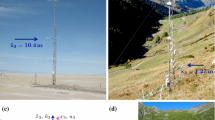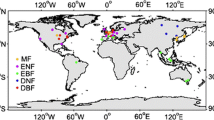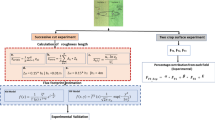Abstract
Seven coordinate rotation systems were compared to determine a suitable system for a forest in complex terrain, using eddy-covariance data for a period of 40 days. The traditional double rotation was set as the standard of comparison with six other fixed coordinate systems, whose coefficients were carefully determined based on wind component data for a two-year period. Differences in total heat fluxes and daytime \(\hbox {CO}_{2}\) fluxes calculated from all systems were small, except those from the sector-wise planar fit, which linearly and systematically underestimated the fluxes by about 5 %. The nighttime \(\hbox {CO}_{2}\) flux was also underestimated by the sector-wise planar fit, but there was significant scatter in the plots, and the mean difference was 7 %. The standard deviations of the wind components and scalars normalized by the friction velocity and the dynamic parameters were calculated for each system, and the errors from the relationships obtained previously from flat and homogenous terrain were examined. The nighttime normalized standard deviation for scalars agreed better with the relationships after applying the sector-wise planar fit than those calculated by the other systems, although no remarkable difference was found in the daytime data. Therefore, the sector-wise planar fit was not the first choice for our site during daytime based on the energy imbalance, which was mainly caused by underestimating daytime heat fluxes. Double rotation or one of the four systems without the roll rotation process might be superior at our site. However, the offset error in the vertical wind component of the sonic anemometer induced errors of several percent in the fluxes in these systems, which was equivalent to the underestimation using the sector-wise planar fit. Meanwhile, the sector-wise planar fit system might still be the best system for calculating nighttime flux, considering the tendency of the nighttime normalized standard deviations.











Similar content being viewed by others
References
Aubinet M, Grelle A, Ibrom A, Rannik U, Moncrieff J, Foken T, Kowalski AS, Martin PH, Berbigier P, Bernhofer Ch, Clement R, Elbers J, Granier A, Grunwarld T, Morgenstern K, Pilegaard K, Rebmann C, Snijders W, Valentini R, Vesala T (2000) Estimates of the annual net carbon and water exchange of forest: the EUROFLUX methodology. Adv Ecol Res 30:113–175
Finnigan JJ (2004) A re-evaluation of long-term flux measurement techniques. Part II: coordinate systems. Boundary-Layer Meteorol 113:1–41
Finnigan JJ, Clement R, Malhi Y, Leuning R, Cleugh HA (2003) A re-evaluation of long-term flux measurement techniques. Part I: averaging and coordinate rotation. Boundary-Layer Meteorol 107:1–48
Foken T (2008a) Micrometeorology. Springer, Berlin 308 pp
Foken T (2008b) The energy balance closure problem: an overview. Ecol Appl 18:1351–1367
Foken T, Göckede M, Mauder M, Mahrt L, Amiro BD, Munger JW (2004) Post-field data quality control. In: Lee X, Massman WJ, Law B (eds) Handbook of micrometeorology: a guide for surface flux measurement and analysis. Kluwer, Dordrecht, pp 181–208
Foken T, Wimmer M, Mauder M, Thomas C, Liebethal C (2006) Some aspects of the energy balance closure problem. Atmos Chem Phys 6:4395–4402
Göckede M, Foken T, Aubinet M, Aurela M, Banza J, Bernhofer C, Bonnefond JM, Brunet Y, Carrara A, Clement R, Dellwik E, Elbers J, Eugster W, Fuhrer J, Granier A, Grünwald T, Heinesch B, Janssens IA, Knohl A, Koeble R, Laurila T, Longdoz B, Manca B, Marek M, Markkanen T, Mateus J, Matteucci G, Mauder M, Migliavacca M, Minerbi S, Moncrieff J, Montagnani L, Moors E, Ourcival J-M, Papale D, Pereira J, Pilegaard K, Pita G, Rambal S, Rebmann C, Rodrigues A, Rotenberg E, Sanz MJ, Sedlak P, Seufert G, Siebicke L, Soussana JF, Valentini R, Vesala T, Verbeeck H, Yakir D (2008) Quality control of CarboEurope flux data—part 1: coupling footprint analyses with flux data quality assessment to evaluate sites in forest ecosystems. Biogeosciences 5:433–450
Ibrom A, Dellwik E, Flyvbjerg H, Jensen NO, Pilegaard K (2007a) Strong low-pass filtering effects on water vapour flux measurements with closed-path eddy correlation systems. Agric For Meteorol 147:140–156
Ibrom A, Dellwik E, Larsen SE, Pilegaard K (2007b) On the use of the Webb–Pearman–Leuning theory for closed-path eddy correlation measurements. Tellus B 59:937–946
Inagaki A, Letzel O, Raasch S, Kanda M (2006) lmpact of surface heterogeneity on energy imbalance: a study using LES. J Meteorol Soc Jpn 84:187–198
ISO (2002) ISO 16622: Meteorology—Sonic anemometer/thermometer—acceptance test method for mean wind measurements, 21 pp
Kaimal JC (1988) In: Mitsuta Y, Yamada M (trans) The atmospheric boundary layer—its structure. Lecture notes. Indian Inst TropicMet Visiting Professorship Program (in Japanese). Gihoudo Shuppan, Tokyo
Kaimal JC, Finnigan JJ (1994) Atmospheric boundary layer flows. Oxford University Press, 289 pp
Kosugi Y, Takanashi S, Tanaka H, Ohkubo S, Tani M, Yano M, Katayama T (2007) Evapotranspiration over a Japanese cypress forest. I. Eddy covariance fluxes and surface conductance characteristics for 3 years. J Hydrol 337:269–283
Lee X (1998) On micrometeorological observation of surface–air exchange over tall vegetation. Agric For Meteorol 91:29–49
Lee X, Finnigan JJ, Paw UKT (2004) Coordinate systems and flux bias error. In: Lee X, Massman W, Law B (eds) Handbook of micrometeorology. Kluwer, Dordrecht, pp 33–66
Leuning R, van Gorsel E, Massman WJ, Isaac PR (2012) Reflections on the surface energy imbalance problem. Agric For Meteorol 156:65–74
Li M, Babel W, Tanaka K, Foken T (2013) Note on the application of planar-fit rotation for non-omnidirectional sonic anemometers. Atmos Meas Tech 6:221–229
Massman WJ (2004) Concerning the measurement of atmospheric trace gas fluxes with open- and closed-path eddy covariance systems: the WPL terms and spectral attenuation. In: Lee X, Massman WJ, Law B (eds) Handbook of micrometeorology. Kluwer, Dordrecht, pp 133–160
McMillen RT (1988) An eddy correlation technique with extended applicability to non-simple terrain. Boundary-Layer Mereorol 43:231–245
Mildenberger K, Beiderwieden E, Hsia YJ, Klemm O (2009) \(\text{ CO }_{2}\) and water vapor fluxes above a subtropical mountain cloud forest—the effect of light conditions and fog. Agric For Meteorol 149:1730–1736
Moore CJ (1986) Frequency response corrections for eddy correlation systems. Boundary-Layer Mereorol 37:17–35
Nakai T, van der Molen MK, Gash JHC, Kodama Y (2006) Correction of sonic anemometer angle of attack errors. Agric For Meteorol 136:19–30
Ono K, Mano M, Miyata A, Inoue Y (2008) Applicability of the planar fit technique in estimating surface fluxes over flat terrain using eddy covariance. J Agric Meteorol 64:121–130
Paw U KT, Baldocchi D, Meyers TP, Wilson KB (2000) Correction of eddy covariance measurements incorporating both advective effects and density fluxes. Boundary-Layer Meteorol 97:487–511
Rebmann C, Kolle O, Heinesch B, Queck R, Ibrom A, Aubinet M (2012) Data acquisition and flux calculations. In: Aubinet M et al (eds) Eddy covariance: a practical guide to measurement and data analysis. Springer, Dordrecht, pp 59–83
Shimizu T (2007) Practical applicability of high frequency correction theories to \(\text{ CO }_{2}\) flux measured by a closed-path system. Boundary-Layer Meteorol 122:417–438
Shimizu T, Suzuki M, Shimizu A (1999) Examination of a correction procedure for the flow attenuation in orthogonal sonic anemometers. Boundary-Layer Meteorol 93:227–236
Shimizu T, Kumagai T, Kobayashi M, Tamai K, Iida S, Kabeya N, Ikawa R, Tateishi M, Miyazawa Y, Shimizu A (2015) Estimation of annual forest evapotranspiration from a coniferous plantation watershed in Japan (2): comparison of eddy covariance, water budget and sap-flow plus interception loss. J Hydrol 522:250–264
Siebicke L, Hunner M, Foken T (2012) Aspects of \(\text{ CO }_{2}\)-advection measurements. Theor Appl Climatol 109:109–131
Su H-B, Schmid HP, Grimmond CSB, Vogel CS, Oliphant AJ (2004) Spectral characteristics and correction of long-term eddy-covariance measurements over two mixed hardwood forests in non-flat terrain. Boundary-Layer Meteorol 110:213–253
Sun J (2007) Tilt corrections over complex terrain and their implication for \(\text{ CO }_{2}\) transport. Boundary-Layer Meteorol 124:143–159
Thomas C, Foken T (2002) Re-evaluation of integral turbulence characteristics and their parameterizations. In: 15th conference on turbulence and boundary layers. American Meteorological Society, Boston, pp 129–132
Turnipseed AA, Anderson DE, Blanken PD, Baugh WM, Monson RK (2003) Airflows and turbulent flux measurements in mountainous terrain. Part I. Canopy and local effects. Agric For Meteorol 119:1–21
Vickers D, Mahrt L (2006) Contrasting mean vertical motion from tilt correction methods and mass continuity. Agric For Meteorol 138:93–103
Webb EK, Pearman GI, Leuning R (1980) Correction of flux measurements for density effects due to heat and water vapour transfer. Q J R Meteorol Soc 106:85–100
Wieser A, Fiedler F, Corsmeier U (2001) The influence of the sensor design on wind measurements with sonic anemometer systems. J Atmos Ocean Technol 18:1585–1608
Wilczak JM, Oncley SP, Stage SA (2001) Sonic anemometer tilt correction algorithms. Boundary-Layer Meteorol 99:127–150
Yuan R, Kang M, Park S, Hong J, Lee D, Kim J (2007) The effect of coordinate rotation on the eddy covariance flux estimation in a hilly Koflux forest site. Korean J Agric For Meteorol 9:100–108
Yuan R, Kang M, Park S, Hong J, Lee D, Kim J (2011) Expansion of the planar-fit method to estimate flux over complex terrain. Meteorol Atmos Phys 110:123–133
Acknowledgments
The author is deeply grateful to Dr. Akira Shimizu of the Kyushu Research Centre of the Forestry and Forest Products Research Institute (FFPRI-KYS) and to Dr. Koji Tamai of FFPRI and Dr. Tomo’omi Kumagai of Nagoya University for their cooperation with the field observations at the KHEW site. In addition, the author appreciates Prof. Masakazu Suzuki of The University of Tokyo for encouragement during this study. KHEW maintenance and management is supported by the Kyushu Regional Forest Office and FFPRI-KYS.
Author information
Authors and Affiliations
Corresponding author
Appendix
Appendix
1.1 High Frequency Correction for the Closed-Path \(\hbox {H}_{2}\hbox {O}\) Flux
Ibrom et al. (2007a) proposed that the closed-path \(\hbox {H}_{2}\hbox {O}\) fluctuation has an attenuated signal in the high frequency region, which is unaccountable based on previous correction theories (e.g. Shimizu 2007). Furthermore, Ibrom et al. (2007b) showed that a signal delay occurs in the closed-path \(\hbox {H}_{2}\hbox {O}\) data compared with that in the \(\hbox {CO}_{2}\) data, although both were simultaneously taken from the sample mouth. We found a similar relationship between relative humidity or vapour pressure deficit (VPD) and the additional signal delay time in \(\hbox {H}_{2}\hbox {O}\) to that in \(\hbox {CO}_{2}\) as Ibrom et al. (2007b) using the class-1 quality control data obtained in June–August 2007 and January–February 2008. The additional delay time was estimated to be 9.5 s when VPD = 2.5 hPa (figure not shown). First, the class-1 data were used to calculate the \(w_\mathrm{r}-\chi _\mathrm{H}\) cospectrum after correcting for sensor separation, the line averaging effect (both in Moore 1986), and the volume averaging effect of the closed-path IRGA (Massman 2004). Then, the cut-off frequencies (\(f_\mathrm{c}\) [Hz]) at which the magnitude of the normalized \(w_\mathrm{r}-\chi _\mathrm{H}\) cospectrum became \((1/2)^{0.5}\) to that of the normalized \(w_\mathrm{r}-T\) cospectrum obtained simultaneously were compiled for four time ranges (14–16, 16–18, 18–22, and 22–30 s). The average \(f_\mathrm{c}\) plotted against typical delay time is shown in Fig. 12; we obtained the relationship between delay time and \(f_\mathrm{c}\) as,
where \(\text {d}t_\mathrm{H}\) is the delay time determined from the maximum correlation between \(w_\mathrm{r}\) and closed-path \(\chi _\mathrm{H}\). The \(f_\mathrm{c}\) estimated from this equation was applied to the \(\hbox {H}_{2}\hbox {O}\) tube flow correction, instead of the theoretical equation.
Cut-off frequency \((f_\mathrm{c})\) calculated from the normalized cospectral ratio of closed-path water vapour flux to sensible heat flux. White circles are bin-averaged of \(f_\mathrm{c}\) by four ranges of delay time estimated from the maximum correlation that occurred. The line represents Eq. 10 in the text
Rights and permissions
About this article
Cite this article
Shimizu, T. Effect of Coordinate Rotation Systems on Calculated Fluxes over a Forest in Complex Terrain: A Comprehensive Comparison. Boundary-Layer Meteorol 156, 277–301 (2015). https://doi.org/10.1007/s10546-015-0027-7
Received:
Accepted:
Published:
Issue Date:
DOI: https://doi.org/10.1007/s10546-015-0027-7





